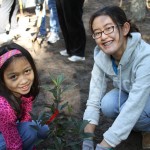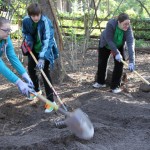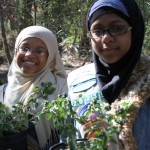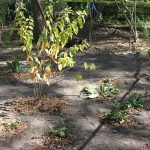
Girl Scouts of San Jacinto plant a native shrub as they build a rain garden at the Houston Arboretum. Photo courtesy of Jodi Stewart Schwarzer, Girl Scouts of the USA project manager. Click for larger image.
Girl Scouts around the country are rolling up their sleeves and working to improve the environment. To celebrate the organization’s 100-year anniversary this year, the Girl Scouts of the United States of America (GSUSA; New York) launched the Girl Scouts Forever Green Take Action Project in July 2011.
Making a difference through local environmental projects and outreach
Through December, Girl Scouts will take action in three main project areas: reducing waste, conserving energy, and building rain gardens, according to a GSUSA news release.
Starting in 2009, the organization worked with 39 of its U.S. offices, known as councils, to develop the project, identifying the project areas as “relevant and of most interest to girls … at various grade levels,” said Jodi Stewart Schwarzer, GSUSA implementation consultant and membership and volunteerism project manager. “They were also replicable, scalable, and would raise visibility for Girl Scouts.”
For many of the projects, girls encourage friends, families, and community members to make lifestyle changes that benefit the environment. Girl Scouts encouraged installing energy-efficient light bulbs and appliances and turning off lights for 1 hour in observance of Earth Hour on March 31 to conserve energy. They also encourage using reusable bottles and bags and recycling to reduce waste, according to the GSUSA website.

Members of the Girl Scouts of San Jacinto prepare soil for rain garden plantings at the Houston Arboretum. Photo courtesy of Schwarzer. Click for larger image.
To increase green space and wildlife habitats while reducing stormwater runoff and improving water quality, Girl Scouts are planting and maintaining rain gardens at schools, homes, and other sites, the website says. Incorporating rain gardens as a major focus of the anniversary Take Action project came from the long history of the girls building gardens and their desire to create green spaces, Schwarzer said.
“Girl Scouts believed focusing on rain gardens would help educate others,” Schwarzer said. “[The gardens] are unique and help not only provide green space and native plants, they help absorb water, reducing runoff pollution, erosion, and filtering the stormwater.”
Girls can find guides, tips, and more information on each project area on the Girl Scouts Forever Green website.
Numerous girls pitch in, and the results add up
Since the project launched last summer, a total of 44,000 people have engaged in projects. About 106,000 new native plants and trees have been placed in 941 rain gardens. This amounts to nearly 2833 m2 (30,493 ft2) of green space, accounting for nearly 13.6 million L (3.6 million gal) of stormwater saved from runoff.
Other project area results are substantial, too. About 14 million kg (31 million lb) of waste has been eliminated, 128 million kWh of energy saved, and 89 million kg (197 million lb) of carbon dioxide reduced — and these numbers will continue to grow throughout the year.
“Environmental conservation is core to the Girl Scout program and is a topic girls care about,” Schwarzer said.
Expanding the project internationally

Members of the Girl Scouts of San Jacinto carry plants to the garden at the Houston Arboretum. Photos courtesy of Schwarzer. Click for larger image.
In addition to many ongoing projects in the United States, the project is being expanded to 20 other countries. A 2-year, $1.5-million grant provided by the Alcoa Foundation (New York) will pair 20 U.S. councils with 20 international councils. A 15-year-old girl from each of the council locations will be selected to lead these projects, inspiring and engaging as many as 400 youths in their communities to participate, Schwarzer said.
“The projects will be completely girl-focused and girl-led,” Schwarzer said. The young leaders will be chosen by June, and then the girls will choose what projects to implement, she added.
“In 2013, we plan to celebrate the impact that took place during our 100th year,” Schwarzer said. “Projects will continue through 2013 as girls and volunteers take this project where they want it to go.”

The arboretum features a new rain garden planted by the Girl Scout troop. Photos courtesy of Schwarzer. Click for larger image.
Girl Scouts features environmental education at its core
To help girls develop as leaders, GSUSA’s National Leadership Program Portfolio includes three National Leadership Journeys book series and The Girl’s Guide to Girl Scouting. One Leadership Journey series, It’s Your Planet — Love It!, is a collection of six books that cover issues of conservation, pollution, and renewable and reusable resources. The books challenge girls to take the lead in protecting the planet, the news release says.
In one of these books, water conservation and protection take a prominent role. WOW! Wonders of Water targets Girl Scouts in second and third grades. The book teaches about the water cycle, introduces women working in water-related careers, and encourages girls to reach out to their community and advocate for others to become involved in protecting water. A Girl Scout troop in Massachusetts decided to urge people to stop wasting water by creating the public service announcement video The Wonders of Water.
The organization also provides girls with online environmental education and activities on its For Girls website.
As you can see environmental issues are interesting for children and they are excited to learn more. Who knows, maybe some of this children will become environmental professionals in the future? Check out NREP.com for current educational program.








May 26, 2012
Achievements, Featured